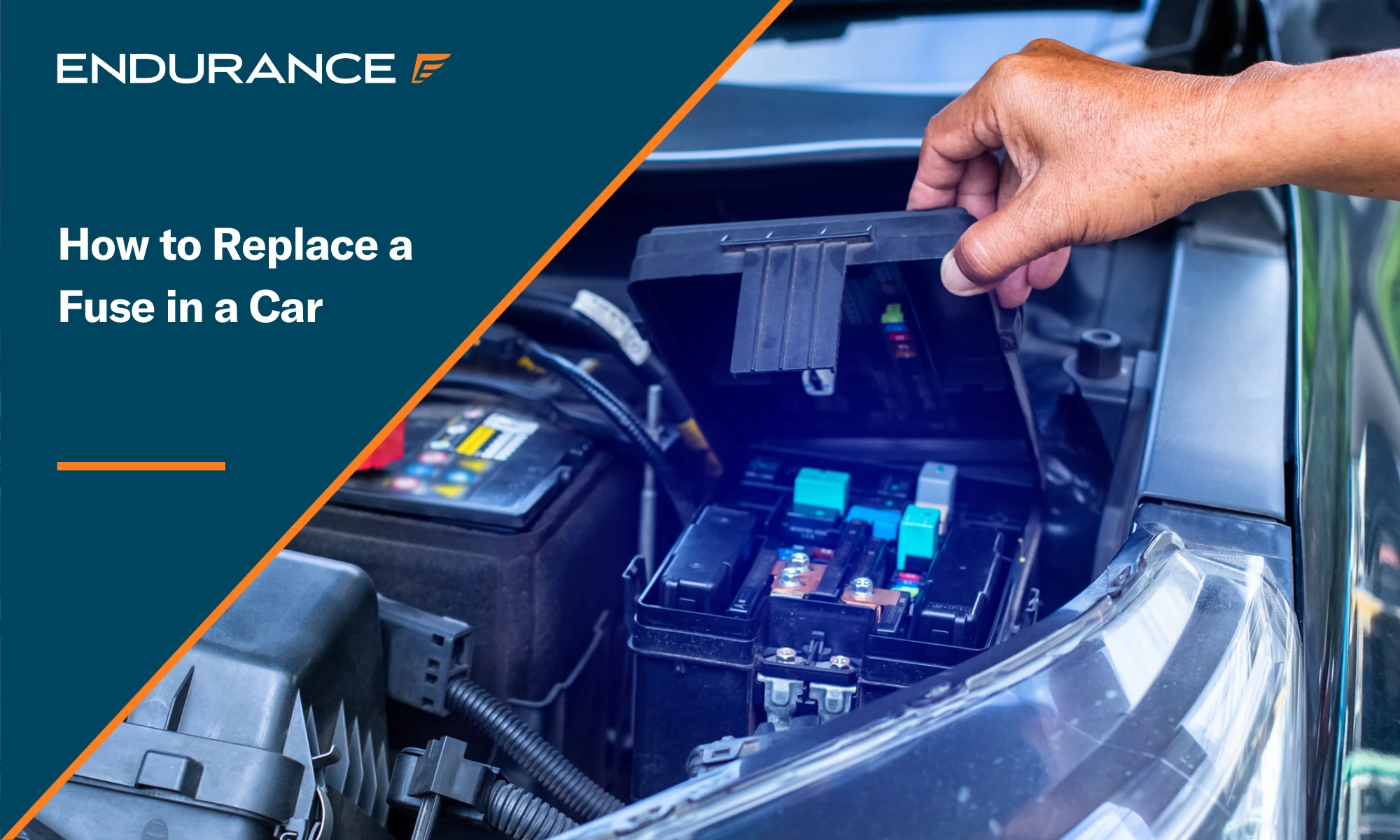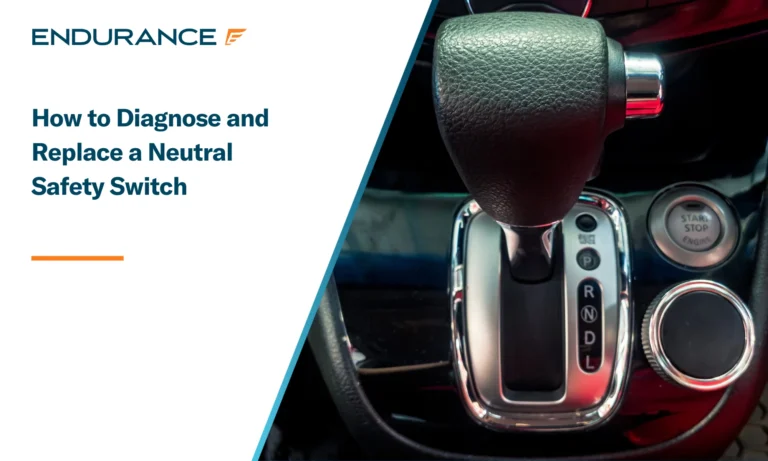How to Replace a Fuse in a Car

Many car owners may never have to deal with a blown fuse, but knowing how to handle this situation can transform a frustrating experience into a minor inconvenience. Your car has dozens of fuses, so there are plenty of opportunities for something to go wrong. A blown fuse can shut down the radio, make the power windows inoperable, or cause the lights to go dark. In some cases, a faulty fuse can leave you stranded.
Even if you’re inclined to head to the mechanic at the slightest car trouble, understanding how to change a fuse is an essential DIY maintenance task. It’s no different than knowing how to add oil or check tire pressure. Changing a fuse on your own will save time and money and doesn’t require much effort or master mechanic-level skills.
Keep reading as we walk you through what’s involved in changing a car fuse.
Understanding Car Fuses and Their Purpose
In simple terms, car fuses safeguard your vehicle’s electrical system. These small, plastic components are designed to absorb the brunt of any electrical current that exceeds normal levels. The idea is that it’s far cheaper and easier to replace an inexpensive fuse than the sensitive and costly component it’s protecting in the event of an electrical spike.
Modern vehicles can have up to 100 fuses, which makes sense considering how much technology is packed into today’s cars. All the computers, sensors, advanced safety equipment, and infotainment gear require electricity, underscoring the importance of the protection offered by fuses.
Most contemporary automobiles rely on blade-type fuses, with variations in size and amperage. These fuse types have been around since the 1970s and incorporate two flat metal prongs connected by a thin metal safety strip and joined by a translucent plastic housing. Most automotive fuses range from 1 to 50 amps (amperage), but large vehicles, like trucks and buses, can have fuses that range up to 120 amps. Fuses are identified by an amperage rating on the top (for instance, ‘10’ indicates a 10-amp fuse) and different color plastic housings. Blade fuses can come in various sizes, depending on the systems they protect.
Always replace a damaged fuse with one of identical amperage and size. Never substitute a defective fuse for one with a different amperage rating.
While older or specialty vehicles may use different fuse types, we’ll focus on blade fuses, which are present in most cars today.
How to Identify a Blown Fuse
The first sign of a blown fuse doesn’t usually come from inspecting the fuse box. Usually, there are other initial symptoms to be aware of. Be on the alert for:
- Electrical components that suddenly stop working or work intermittently
- Multiple related systems that fail simultaneously
- A burning smell from the fuse box
- The sudden illumination of a dashboard warning light
With one or more of these symptoms present, you’ll want to open your car’s fuse box (see below for locating the fuse box) and begin a visual inspection. Look for:
- A broken or darkened metal safety strip visible through the transparent housing
- A cloudy or discolored fuse housing
- Dark residue around the fuse terminals
- A bulging or deformed fuse casing
A working fuse contains a thin metal safety strip visible through its transparent housing. In a blown fuse, this strip appears broken or darkened. Many modern fuses feature a small window on top that turns dark when the fuse fails, making identification even easier. Some luxury vehicles even include electronic fuse monitoring that alerts you through the dashboard display when a fuse requires replacement.
Locating the Fuse Box in Your Vehicle
Most vehicles have two or more fuse boxes: one under the hood for major engine components and another inside the cabin for interior electronics. Some larger vehicles or luxury models might have additional fuse boxes for specialized systems.
Primary Fuse Box Locations
The under-the-hood fuse box is usually located near the battery and protected by a weather-resistant cover. It often contains fuses that protect high-drain systems, such as the powertrain management system, the cooling fans, the fuel pump, and the charging system.
The cabin fuse box is usually part of or adjacent to the dashboard. It might be under the steering wheel, in the glove box, or beneath a panel near the instrument panel. These fuses cover power windows and locks, the radio or infotainment system, climate control, interior lighting, and accessory power outlets.
The owner’s manual will provide fuse box locations and a detailed diagram of the individual fuses and their functionality. If the manual isn’t available, you can locate fuse box information online; just be sure to use a reliable source (like the manufacturer’s website). Alternatively, some automakers include a simplified fuse diagram inside the fuse box cover for quick reference.
Step-by-Step Guide to Replacing a Car Fuse
While multiple steps are involved in replacing a car fuse, they’re not overwhelming for most drivers. Here’s a checklist to follow:
Preparation:
- Park the car on level ground
- Turn off the ignition and remove the key
- Engage the parking brake
- Have replacement fuses and a fuse puller ready
- Gather a flashlight or work light
- Consider having needle-nose pliers as backup for the fuse puller
- Keep the owner’s manual nearby for reference
Identify the Correct Fuse:
- Consult the owner’s manual to locate the specific fuse
- Note the amperage rating (typically 5-30 amps)
- Match the color coding to the replacement
- Take a photo of the fuse layout for reference
- Write down the fuse position if the diagram isn’t clear
Remove the Defective Fuse:
- Use the fuse puller; it looks like large tweezers (usually stored in the fuse box)
- If no puller is available, carefully grip the fuse with needle-nose pliers
- Pull the fuse straight out to avoid damaging surrounding components
- Inspect the removed fuse carefully
- Check the fuse socket for any signs of damage or corrosion
Install the New Fuse:
- Select a replacement fuse of identical amperage
- Verify the color code matches
- Check that the physical size and style match exactly
- Insert the replacement fuse carefully
- Ensure it seats firmly in the socket
- Don’t force it if there’s resistance
- Close the fuse box cover securely
Testing and Verification:
- Start the vehicle
- Test the previously affected component
- Check for any warning lights
- Listen for unusual sounds
- Monitor the component for several minutes
- If it still doesn’t work, consult a professional
Safety Tips for Working with Fuses
Although the actual process of replacing a blown fuse is straightforward, there are numerous safety considerations. It’s no different than being cautious around electricity in your home. Here are essential safety tips to follow when working with car fuses:
Never Substitute Incorrect Amperage:
- Don’t use a different amperage fuse—this can lead to overheating, a fire risk, and electrical system damage
- Don’t use makeshift alternatives like aluminum foil
- Keep correct spare fuses in the glove compartment
- Purchase a variety pack of common fuse sizes
Battery Safety:
- Consider disconnecting the negative battery terminal before working in the fuse box
- Wear insulated gloves if possible
- Keep metal tools away from battery terminals
- Work in a well-ventilated area
- Remove jewelry and watches
Diagnostic Awareness:
- If a fuse blows repeatedly, there’s likely an underlying issue to diagnose
- Multiple blown fuses indicate a serious electrical problem
- Document any changes you make to the electrical system
- Keep track of when and how often fuses blow
- Consider having a professional inspection if problems persist
Environmental Considerations:
- Only work in the fuse box with dry conditions—don’t expose fuses to rain or other moisture
- Ensure there’s adequate lighting
- Keep children and pets away from the work area
- Have a fire extinguisher nearby
- Dispose of old fuses properly
How Endurance Warranty Covers Electrical System Repairs
Electrical issues that go beyond replacing a fuse often involve significant auto repairs. An extended car warranty (also called a vehicle service contract), like several plans offered by Endurance, protects against expensive electrical system repairs.
Several Endurance auto protection plans provide coverage for electrical components, including:
- Computer modules and control units
- Wiring harnesses and connections
- Alternator and starter systems
- Power window and door lock motors
- Advanced safety systems
- Navigation and entertainment systems
Most Endurance Warranty plans cover essential electrical components, with options available for more complex systems. Endurance customers enjoy numerous benefits, including:
- 24/7 roadside assistance with towing and other services
- Rental car reimbursement
- Trip interruption protection
- Flexible payment options
- Choice of any licensed repair facility
All plans include a year of Elite Benefits. Just pay a small activation fee for access to up to $2,000 of valuable services such as tire repairs and replacements, key fob replacement, collision repair discounts, and total loss protection.*
Unmatched Warranty Protection from Endurance
Discover all the advantages of Endurance Warranty by requesting a FREE quote or visiting the Endurance online store for instant plan recommendations and pricing. Call an Endurance advisor at (800) 253-8203 for personalized assistance.
Check out the Endurance blog for insightful articles on car repairs, DIY advice, auto reviews, and more.













As both an Army Veteran & ASE Certified repair shop owner, Andrew has made educating the modern driver an ongoing mission since the opening of his repair shop, Midwest City Autospa, in 2012. Read more about Andrew.